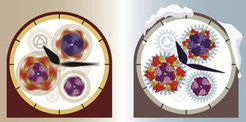Operation of ancient biological clock uncovered

A team of Dutch and German researchers under the leadership of Albert Heck and Friedrich Förster has discovered the operation of one of the oldest biological clocks in the world, which is crucial for life on earth as we know it. The researcher from the Max Planck Institute of Biochemistry and the Utrecht University applied a new combination of cutting-edge research techniques. They discovered how the biological clock in cyanobacteria works in detail. Important to understand life, because cyanobacteria were the first organisms on earth producing oxygen via photosynthesis. The results of their research were published in Science.
Ten years ago, researchers discovered that the biological clock in cyanobacteria consists of only three protein components: KaiA, KaiB and KaiC. These are the building blocks - the gears, springs and balances - of an ingenious system resembling a precision Swiss timepiece. In 2005, Japanese scientists published an article in Science showing that a solution of these three components in a test tube could run a 24-hour cycle for days when a bit of energy was added. However, the scientists were not able to uncover the exact operation of the system, despite its relative simplicity.
William Faulkner
How could the scientists resolve the working of the individual pieces? “In the end, the trick to understand the ticking biological clock in cyanobacteria was to literally make time stop”, tells research leader Albert Heck from Utrecht University. “Or as William Faulkner, Nobel Prize Laureate in Literature said: ‘Only when the clock stops does time come to life.’ Faulkner spoke taking a pause in the constant haste of life. That was also the trick here. We slowed the biological clock by running it in the fridge for a week. In the literal sense we have frozen the time.”
